#Queen Nefertari Playing Senet
Text
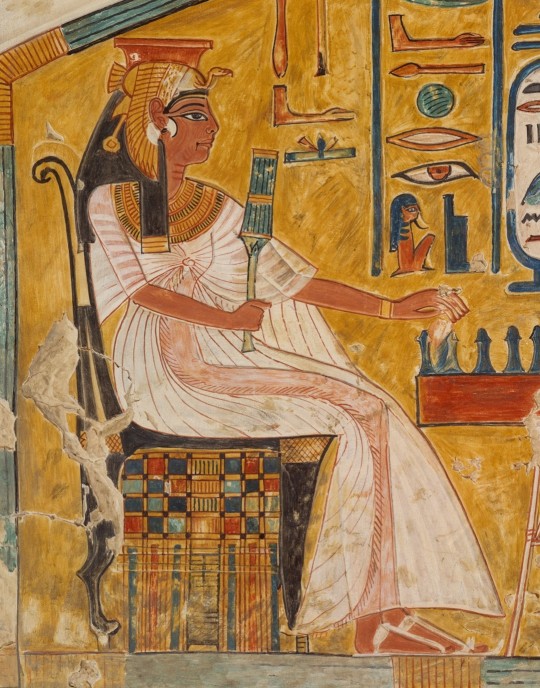
Queen Nefertari Playing Senet - Met Museum Collection
Note: This is a modern copy of an original
Inventory Number: 30.4.145
Original Dating: New Kingdom, Ramesside, Dynasty 19, ca. 1279–1213 B.C.
Location Information: Original from Egypt, Upper Egypt, Thebes, Valley of the Queens (Biban el-Malikat), Tomb of Nefertari (QV 66)
Description:
This facsimile copies of one of the paintings from Nefertari's tomb. In this vignette, the queen sits in front of a table playing a game of senet again an invisible opponent. This was a popular game in life, but when represented in a tomb, as here, it has symbolic meaning. The word senet means "passing" and the game was seen as a parallel to the journey into the afterlife and the obstacles one had to overcome on the way.
In the scene, Nefertari wears an elaborately pleated and fringed gown of sheer linen. She also wears a gold bracelet, a broad collar, and what are probably silver earrings. On her head is the vulture headdress of a queen. The facsimile was painted at the tomb in 1921-1922 by Nina deGaris Davies who was a member of the Graphic Section of the Museum's Egyptian Expedition.
#Queen Nefertari Playing Senet#new kingdom#ramesside#dynasty 19#upper egypt#thebes#valley of the queens#tomb of nefertari#met museum#30.4.145#womens clothing#NKRWC
3 notes
·
View notes
Photo
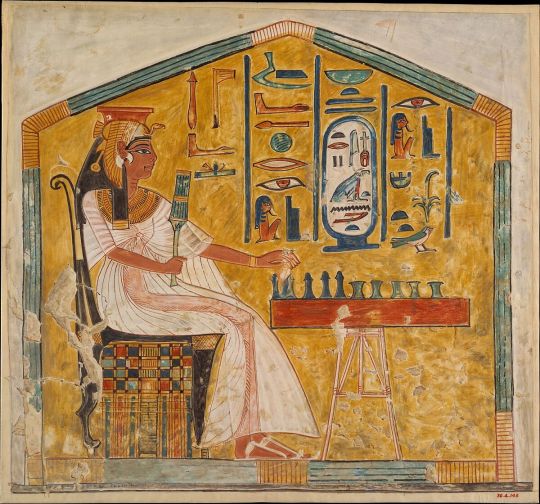
Queen Nefertari Playing Senet. ca. 1279-1213 B.C. Facsimile by Nina de Garis Davies, 1921-1922 (she even included the cracks and chips!)
https://www.metmuseum.org/art/collection/search/548355
5 notes
·
View notes
Text
The Past and Future of Board Games

The global board game market exceeded $15.5 billion in 2021 and is expected to see a 9.2 percent compounded annual growth rate (CAR) through 2030, at which point it will reach an estimated value of $34.35 billion. Board games are big business in the United States, with sales topping $1.75 billion in 2022. Despite a slightly lower CAGR, the domestic market has been forecast to approach $2.9 billion by 2027. Before looking ahead to the future of the global and domestic board game markets, it can be interesting to look back at the industry’s development over time.
The oldest playable board game ever created is the Royal Game of Ur. A mostly intact board was discovered in southern Iraq at the Royal Cemetery of Ur. The roughly 4,600-year-old game was found with written instructions, allowing curator Irving Finkel to translate the rules of the game, which amounted to a race between two players across the board. The game was something of a spiritual artifact as well, as the center pieces on the board required players to have their fortunes read. Interested individuals can learn the rules and watch live play videos online, or even purchase their own replica of the Royal Game of Ur.
Senet is another ancient board game. A favorite of Egyptian pharaoh Tutankhamun and Queen Nefertari, the game’s origins can be traced back to 3,100 BC. Despite having a completely different board design, senet was similar to the Royal Game of Ur in that it involved two players racing one another across the board. While most modern board games would use dice to help players cross the 30 square tiles from start to finish, Egyptians played with bones and casting sticks. Boards were often made of hollow wood and ivory and decorated with hieroglyphs, some of which described additional game rules.
Mahjong is a game that bridges the past and present. The game originated during China’s Qing dynasty, which lasted from 1644 through 1912. The four-player strategy-based game is comparable to rummy, with players attempting to discard their 14 tiles into four sets and one pair. Mahjong made its way to western cultures during the 1800s and has remained a popular game on the international stage ever since.
The most successful modern board game of all time is Monopoly. Lizzie Magie invented the game as The Landlord’s Game in 1908. Parker Brothers copied the game in 1935 and has since developed countless brand spin offs, such as Star Wars Monopoly or Lord of the Rings Monopoly. By 2015, all versions of Monopoly had combined to sell more than 275 million copies. Monopoly is followed in sales by other modern games such as Scrabble, Clue, Battleship, and Trivial Pursuit.
The future of the board game industry looks bright, with the COVID-19 pandemic reminding many Americans and families around the world of the fun and strategy involved with various games. One interesting trend is the development of more complex niche board games made possible by platforms such as Kickstarter. For example, Restoration Games’ Return to Dark Tower Kickstarter campaign raised over $4 million for a game that cost $125.
1 note
·
View note
Text
A Great Timeline
Throughout the years of time, art has had the opportunity to grow and progress, while changing the course of history in the process. The advancements in art throughout time, from the prehistoric Paleolithic period until the Late Medieval period in Italy, brought about ways in which both self-expression and identity could be discovered and portrayed through art while also celebrating cultural and religious beliefs.

Beginning at approximately 33,000 to 30,000 BCE in what is considered the Paleolithic Period, some of the first examples of paintings and engravings by humans were created. Covering the walls of the Chauvet Cave in southern France are hundreds of paintings and engravings featuring handprints, geometric patterns, and over 400 representations of different animal species. The prehistoric creators of these works of art scraped their wall canvases clean before utilizing charcoal, manganese dioxide, and hematite to create forms of paint. In a time in which language, ideas, techniques, and cultures were still forming, the paintings of the Chauvet Cave show that the people of the Paleolithic Period respected and valued the beauty of nature. The handprints on the walls provide one of the very first representations of a sense of identity. While it remains a subject of debate, there is the possibility that the paintings of the cave have symbolic and religious importance, and that the art might have played an important role.
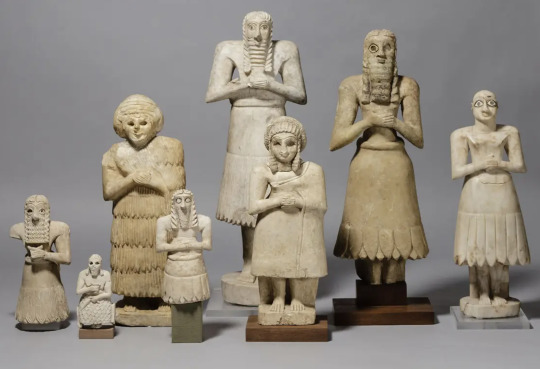
The Sumerian culture of Mesopotamia excelled greatly in forms of art such as pottery, sculpting, weaving, and the creation of large architectural structures called ziggurats. Religious values and beliefs were of extreme importance, something that is reflected in both the artwork and architecture of the Sumerian people. The votive figures known as The Sumerian Worshipers from the Temple of Tell Asmar date from approximately 2900 to 2600 BCE. Crafted from limestone, alabaster, and gypsum, each has its own individualized size and appearance, yet all stand in the same solemn upright stance. The large, focused eyes display the attentive and respectful gaze towards the deities that they believed in and were dedicated to worshipping.
Some of the Sumerian votive figures that have been recovered have names inscribed on them, a portrayal of individuality incorporated with celebrating religious beliefs. The votive figures of this time period are an early example of religious sculptures, an inspiration for the advancements in religious art that were yet to come.
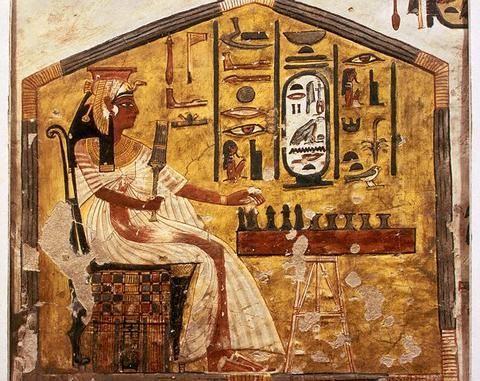
The Egyptian people had a fierce devotion to their rituals and beliefs, especially when it came to the event of death. To the Egyptians, death was not considered to be the end, and a great amount of time went into the creation of individual tombs and coffins to help the deceased on their way to the afterlife. The paintings within Egyptian tombs show the clear devotion that Egyptians had to their rituals and beliefs, and the hopefulness and determination that they had to achieve their goal of eternal life.
Located in Thebes in the Valley of the Queens, Queen Nefertari’s tomb is considered to be the largest, most well-known, and exquisitely embellished tomb of the site. A woman well ahead of her time, Queen Nefertari was very educated and highly active in the diplomacy of her country. In the tomb painting Queen Nefertari Playing Senet dated from approximately 1279 to 1213 BCE, Nefertari is sitting playing the game of senet while dressed in her regal attire. The complicated game involves thirty squares which can help or hinder a player’s progression to winning against their opponent. When shown in a tomb, the squares symbolically correlate to the assistance or threats that a person might face while on their way to the afterlife. Nefertari is shown playing senet alone, illustrating her independent struggle and fierce determination to win on her journey through life and achieving immortality.

Known for their Classical art and emphasis on honoring gods or the achievements of rulers, the Greeks could at times focus on softer, more personal art. To honor their dead, the Greeks would use stone slabs called stelai (singular is referred to as stele) and carve images of the person to be remembered for use at the burial site in the cemetery. Marble grave stele of a young woman and servant circa 400 to 390 BCE portrays the typical Classical Greek style, but in a more intimate way. A woman is shown leaning in a pose potentially inspired by Aphrodite. Standing beside her with a jewelry box is a younger, smaller girl with her hair cut short in mourning. There is a tenderness between the two, insinuating that there is a possibility that they are sisters rather than mistress and servant. The Greek people were able to show individualized depictions of lost loved ones, while still honoring their gods and cultural beliefs in regard to death.
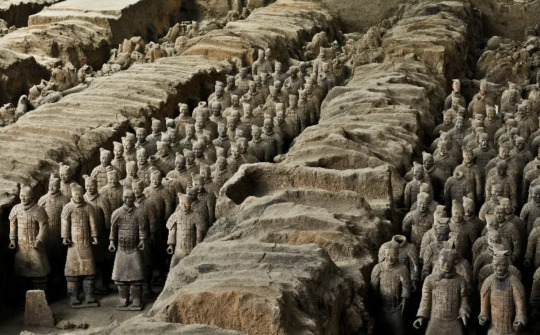
The Qin Dynasty ushered in China’s first emperor, Shihuangdi. Shortly after taking over the throne, Emperor Shihuangdi began the construction of his large tomb which took almost four decades to complete. Though the tomb blends in with the lush natural landscape from the outside, the inside consists of several thousand terracotta soldiers complete with 100 wooden chariots. The soldiers stand ready for battle, some with remaining traces of bronze or wooden weapons. Each soldier has a similar yet different face, with each having slightly unique and abstracted physical or facial features. Emperor Shihuangdi is said to have had hundreds of thousands of men in his army that protected his empire. Even in death, his terracotta soldiers proudly and symbolically stood to guard and protect their ruler and his final resting place. The Chinese were exceptionally skilled and achieved great artistic and technological advancements that have been beneficial contributions to the world. Shihuangdi’s mausoleum of soldiers brings the cultural belief of protecting the spirit into an exceptionally lifelike and artistically revolutionary portrayal.
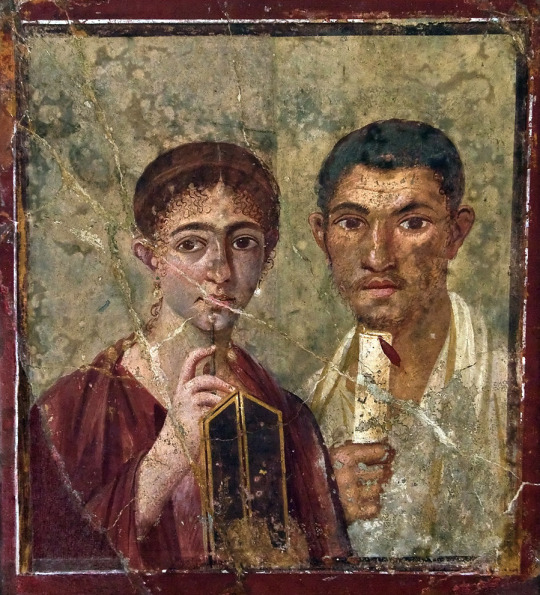
Portrait of a Married Couple (Terentius Neo and Wife) from approximately 75 CE illustrates the advancement of personal portraits in the era of Imperial Rome. Instead of the ideal proportions and features of the Classical style, the lineaments of the couple are extremely lifelike. From the spacing of the eyes, to the shapes of the ears and mouths, it is safe to assume that this wall painting resembles what the pair would have looked like in actuality.
Not only do the physical characteristics of the pair create a more personalized work of art, but the objects that they hold in their hands also signify even more about them in a subtle way. Terentius Neo holds a scroll, displaying his academic achievements. His wife holds a writing tablet with a stylus, demonstrating her abilities to read and write. This portrait is of two educated individuals that were proud of their accomplishments and were able to express it through art. It is also worth noting that this portrait shows a wife at the same level as her husband, something relatively rare for the time period. Rather than being painted smaller in the hierarchal scale or shown without her writing utensils, she was shown as the intelligent and equal woman that she was.
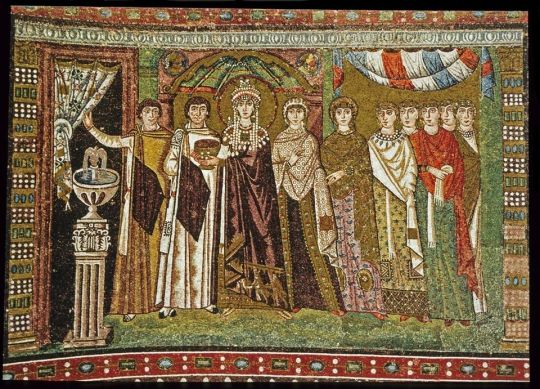
In the Basilica of San Vitale located in Ravenna, Italy, the south wall of the apse features the impressive mosaic Empress Theodora and her Attendants from the year 547 CE. San Vitale contains some of the largest, most intricate, and best-preserved mosaics of the Early Byzantine period. While Emperor Justinian was an avid church builder, Empress Theodora was the main driving force behind the design and construction. Her place in prominent artwork that mirrors the mosaic of Emperor Justinian and his Attendants, located on the north wall, displays both her regal importance and influence. Dressed in royal purple with a nimbus around her head to symbolize her power, Empress Theodora is shown bringing offerings to Jesus Christ.
The mosaics throughout the Basilica of San Vitale follow the theme of offering, something of great importance to the Christian religion. Empress Theodora and her Attendants, along with the other mosaics of San Vitale, portray self-expression and identity as well as the high regard that religious beliefs were held.

Considered to be “the first great monument of Islamic art,” the Dome of the Rock was created at the location where Muhammad is said to have been lifted to Heaven. The rock is also believed to be the site in which God created Adam, the place in which Abraham was commanded by God to sacrifice his son, as well as the location of the temple of Solomon. While it is of great importance to the Muslim people due to Muhammad, it also is significant to those of the Jewish and Christian faiths as well due to these other biblical stories. Completed in 691, the Dome of the Rock is the Islamic religion’s way of honoring itself and its beliefs through architecture. With its beautiful marble detailing and stunning glass mosaics combined with Byzantine style, it stands tall as a way to honor the triumph of the Islamic religion. The Dome of the Rock serves as a reminder of the unique connections between different religions and remains a very holy site to this day.

The mid 11th through the 12th centuries brought about the introduction of Romanesque art. Quite literally meaning “Roman-like,” this style of art took inspiration from Roman art while also merging other artistic and local styles and traditions to form something all its own creation. Hildegard of Bingen’s book paintings are a great example of the Romanesque style. As a very young child, Hildegard was said to have begun receiving holy visions from God. She began recording these visions, creating books filled with words and powerful images. The Universal Man illumination from Liber Divinorum Operum circa 1165 shows the rare self portrait of Hildegard herself. Seated at the lower left-hand corner, Hildegard is shown recording the vision of the man. This sense of identity and self-expression in what is considered a holy artwork is revolutionary, especially for a woman of the time.
Taking inspiration from the Romans, the man shows ideal proportions and appears to be at one with the world. At the very top, we see the head of God above his creation of man. The Universal Man shows immense similarities to Leonardo da Vinci’s ideal proportioned Vitruvian Man three centuries or so later, and captures how Roman artistic influences have continued on throughout time.
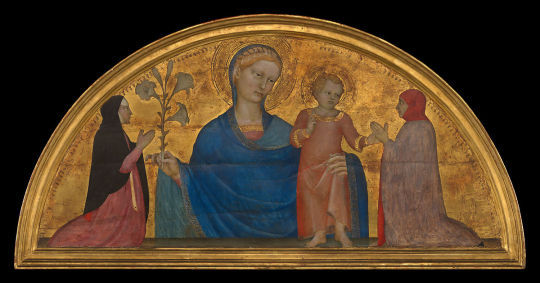
Italy in the 13th century faced political problems as the Holy Roman Empire fought to maintain full control. Many individuals, particularly those of higher classes, commissioned art with religious themes to show their dedication to the Church and to their faith. Late Medieval Italian art such as Giovanni da Milano’s Madonna and Child with Donors from the year 1365 exhibits a couple being welcomed into Heaven by the Madonna and an infant Jesus Christ. Most likely set above a tomb, the donors were able to honor their religious beliefs even after death. The tempera on wood painting with gold ground may portray flatter and more two-dimensional figures, but the symbolism is as bold as ever. With hands clasped in prayer, the couple celebrates their faith through art while incorporating themselves into it.
In conclusion, the evolution of art has been both noteworthy and largely significant. What began in the Paleolithic Period as simple paintings and engravings of animals and geometric shapes on the walls of caves led the way to more individualized and self-expressive works of art. From the embellished tomb walls of the Egyptian New Kingdom, the defensive Qin Dynasty’s terracotta soldiers, the lifelike and symbolic wall portrait paintings of Imperial Rome, the mosaics of Byzantine churches, to the first Islamic architecture all the way to Late Medieval Italy’s portrayals of real people devoted to their faith. Each time period brought about some sort of change in the history of art and incorporated ways in which both self-expression and identity could be discovered and portrayed while also celebrating cultural and religious beliefs.
0 notes
Photo

Queen Nefertari Playing Senet by Nina de Garis Davies
4 notes
·
View notes
Photo

MWW Artwork of the Day (2/12/20)
Nineteenth Dynasty (Egyptian, 1292-1189 BCE)
Queen Nefertari Playing Senet (c. 1279–1213 BCE)
Tempera on paper, 43 x 46 cm.
The Metropolitan Museum of Art, New York (Rogers Fund)
This facsimile copies of one of the paintings from Nefertari's tomb. In this vignette, the queen sits in front of a table playing a game of senet again an invisible opponent. This was a popular game in life, but when represented in a tomb, as here, it has symbolic meaning. The word senet means "passing" and the game was seen as a parallel to the journey into the afterlife and the obstacles one had to overcome on the way. In the scene, Nefertari wears an elaborately pleated and fringed gown of sheer linen. She also wears a gold bracelet, a broad collar, and what are probably silver earrings. On her head is the vulture headdress of a queen. This facsimile was painted at the tomb in 1921-1922 by Nina deGaris Davies (1881–1965) who was a member of the Graphic Section of the Museum's Egyptian Expedition. (from the MMA catalog)
28 notes
·
View notes
Text
ANCIENT KEMETIC SENET BOARD GAME
This is a painting from the 19th dynasty Kamite (Ancient Egyptian) tomb of Queen Nefertari. This is about 3300 years ago. She is playing a board game called Senet. I think that Senet is a forerunner of the game of chess. The tomb of Nefertari, the principal wife of Ramses the Great, is in the Valley of the Queens on the West Bank of the Nile in Luxor, Egypt. It is rarely open to the public but I believe that I have been able to enter on at least two of my trips to Egypt. ~Ancestor Runoko Rashidi

21 notes
·
View notes
Note
1. was there really real life shadow games being played by ancient egyptians back in the day? please dont be skeptical because theres the story about the sorcerer prince who challenged a ghost to a shadow game after trying to steal the book of thoth i just want you to tell me if there are other real life ancient egypt legends about something similar to a shadow game 2. i know atum is just a god but was there a pharaoh named after him?
Hi there :) Thank you for your ask and trusting me with an answer! I'll do my best to answer you properly.
1. I wasn't sure to what you were refering to at first but I think you're talking about a short passage in the story known as "Setne-Khamwas and Naneferkaptah" where the dead prince Naneferkaptah tries to stop the living prince Setne from stealing the Book of Thoth / Book of knowledge. Naneferkaptah challenges Setne to a game of senet (most probably). And every time he wins he strikes Setne with a magic spell. However this game is not refered to as a "shadow game" (this name is from ygo only). But it is possible that Kazuki Takahashi got inspired by this story to create his "shadow games".
In Egyptian culture, the senet game was linked with the idea of gaining magical knowledge and garantying a safe travel through the underworld (the idea is briefly mentionned in Coffin Texts, 2000 - 1800 BC, and other later funerary texts). Hence why you can find senet board games in tombs and scenes where the king/queen/deceased person is playing senet (see Tomb of Nefertari or scenes of Ramesses III playing with his daughter at Medinet Habou Temple). Note, however, that these scenes are from the Late New Kindgom only (1200 - 1100 BC). The idea, though, have survived in Egyptian beliefs since we have a much later reference to the game being associated with knowledge in the story of Setne which you were refering to, written in the 3rd century BC.
Other than that, I don't know any other scenes or reference to the senet game associated with magical knowledge elsewhere. It could just be because we lost some other occurrences though.
Also, it is highly probable that Egyptians made the difference between playing the game for fun when you were happy and alive and the symbolism of putting a senet game in a tomb for safe passage in the underworld.
I hope i wasn't too long and that it answers your question correctly!
2. Egyptian pharaohs had usually several names. Nowadays, we mostly use their birth name. None of them were named "Atum" at birth. However the component 'atum' can sometimes be found in other names of pharaohs (names that were given to them at their coronation). Like Ramesses V Golden Horus' name which is : "his years are powerful like (the years of) Atum".
28 notes
·
View notes
Photo










Art In Marvel Comics
Age of Apocalypse Variant Cover #2 (2011) - Inspired by Queen Nefertari playing senet
Invincible Iron Man Variant Cover #515 (2008) - Inspired by Moai Statues
Interior from Civil War II #8 (2016) Inspired by La Pieta by Michaelangelo
Uncanny X-Force Variant Cover #24 (2010) - Inspired by A Sunday Afternoon On The Island Of La Grande Jatte by Georges Surat
Interior from Daredevil #51 (1998) - Inspired by Self-portrait by Vincent Van Gogh
#age of apocalypse#avengers#vincent van gogh#egyptian art#iron man#maya lopez#echo#daredevil#invincible iron man#marvel comics#moai#statues#la pieta#civil war#tony stark#miles morales#georges surat#marvel edit#daily marvel#art
302 notes
·
View notes
Photo










50 Ancient Coffins Uncovered at Egypt's Saqqara Necropolis
The Egyptian mission working in the Saqqara archaeological site next to the pyramid of King Teti, the first king of the Sixth Dynasty of the Old Kingdom, announced important archaeological discoveries dating back to the old and New Kingdoms in Saqqara.
The mission is headed by Dr. Zahi Hawass, who works in cooperation with the Ministry of Antiquities and through Bibliotheca Alexandrina.
These discoveries will rewrite the history of this region, especially during the 18th and 19th dynasties of the New Kingdom, during which King Teti was worshiped, and the citizens at that time were buried around his pyramid.
The mission confirmed that the entrance to the Saqqara region in the New Kingdom was through this area.
The mission discovered the funerary temple of Queen Nearit, the wife of King Teti, part of which was already uncovered in the years prior.
The mission discovered the layout of the temple in which the queen’s tomb was being revived, and the mission also found within the temple three mud-brick warehouses attached to the temple in the southeastern side - these stores were built to store temple provisions, offerings and tools that were used in the queen’s tomb.
Among the most important discoveries of the mission also at the site was the unveiling of 52 burial shafts, that reach to 10-12 meters deep, and inside these shafts hundreds of wooden coffins dating back to the New Kingdom were uncovered.
This is the first time that coffins dating back 3,000 years have been found in the Saqqara region.
These coffins are wooden and anthropoid, and are many scenes of the gods that were worshiped during this period were represented on the surface of the coffins, in addition to various excerpts from the Book of the Dead that help the deceased to pass through the journey of the other world.
Indeed, as well as in the modern state.
The discovery confirmed that the Saqqara area was not used for burial during the Late Period only, but also during the New Kingdom.
The mission also succeeded in discovering a cache of anthropoid wooden coffins. Inside this shaft, 50 coffins were found in good condition.
The mission uncovered a luxurious mud-brick shrine dating back to the New Kingdom, it reaches to a depth of 24m below the ground level without hitting the burial chamber yet.
The open court of the shaft was paved with well-polished and shiny limestone slabs, and this is the first time that a shaft with this depth has been found, and work is still in progress, and Dr. Zahi Hawass believes that this shaft was not looted by thieves, and it will be fully disclosed.
The discoveries found in the shaft are considered one of the most important findings uncovered in the Saqqara region, and date back to the New Kingdom.
This discovery confirmed the existence of many workshops that produced these coffins, which were bought by the locals, as well as mummification workshops.
Inside the shafts, the mission discovered large numbers of archaeological artifacts and a large number of statues that represents deities such as the god Osiris and Ptah-Soker-Osiris, in addition to a unique discovery, where the mission found a papyrus, whose length reached four meters in length and one meter in width, representing Chapter 17 from the Book of the Dead, and the name of its owner is recorded on it (Pw-Kha-Ef).
The same name was found on four shabty statues, and on an anthropoid wooden coffin.
Many beautiful shabty statues made of wood, stone and faience have been found dating back to the New Kingdom.
The mission also found many wooden funerary masks as well as a shrine dedicated to god Anubis (Guardian of the Cemetery) and beautiful statues of Anubis, as well as many games that the deceased used to play in the other world, such as the game (Senet), which is similar to the modern chess. as well as the (Twenty) game with the name of the player recorded.
Many artifacts were found that represent birds such as geese, as well as a magnificent bronze ax, indicating that its owner was one of the army leaders during the New Kingdom.
A wonderful well preserved limestone stelae was found in one of the excavated shafts, it belongs to a man named Kha-Ptah and his wife Mwt-em-wia.
The upper part of the stelae represents the deceased and his wife in an adoration gesture in front of god Osiris, while the lower part represents the deceased sitting and behind him his wife seated on a chair.
Below the chair of the wife there is one of their daughters sitting on her legs and smelling the lotus flower, and above her head is the ointment flask.
In front of the man and his wife we see six of their daughters and sons, who were depicted in two registers, the upper one for seated daughters smelling the lotus flowers and above their heads are the ointment flasks, and the lower one for standing sons.
The thing that grabs our attention that one of their daughters bear the name Nefertary, named after the beloved wife of king Ramesses II, who built her a marvelous tomb at Valley of the Queens as well as a temple at Abu Simbel.
In addition to that, one of his sons was names Kha-em-waset, named after one of the sons of King Ramesses II, and he is considered a wise man, and known as the first Egyptologist, who used to restore the antiquities of his ancestors.
As for the titles of the owner of the stela, he was the overseer of the king’s military chariot, which indicates his prestigious position during the 19th Dynasty.
The mission also found impressive quantities of pottery dating back to the New Kingdom, including pottery that gives us evidence about the commercial relations between Egypt and Crete, Syria, Palestine.
Dr. Sahar Selim, a professor of radiology at Qasr al-Aini, conducted studies on mummies using X-ray, and determined the causes of death and the age of the deceased on death, as well as studying a mummy for a young child.
The mission studied the mummy of a woman and determined that this woman suffered from a chronic disease known as "Mediterranean fever" or "swine fever", a disease that comes from direct contact with animals and leads to an abscess in the liver.
Dr. Zahi Hawass confirmed that this discovery is considered the most important.
#50 Ancient Coffins Uncovered at Egypt's Saqqara Necropolis#history#history news#archeology#mummy#mummies#ancient egypt#pyramids#egyptian pyramids#egyptian#egyptian pharaohs
6 notes
·
View notes
Photo

Queen Nefertari Playing Senet (ca. 1279–1213 BC).𓏤 Nefertari Meritmut (𓏏𓅐𓄤𓇋𓏏𓂋𓏭𓈘𓏏) “nfr-ti-ri-mer.t-mwt” ‘Nefertari, Beloved of Mut’ was the great Royal-Wife 𓇓𓈞𓏏 “sw-hm.t”, or principal queen, of Ramesses II- Meryamun-Ramess (𓇋𓏠𓈖𓌺𓁛𓄟𓋴) ‘Rameses, Beloved of Amun’.𓏤 Her importance to the king is evident in the monuments he created to honor her. At Abu Simbel, the Ramesses constructed 𓂓𓏏𓀋 “kA.t” a small rock-cut temple 𓉞𓉐 “hw.t” for her next to his own and, for her burial 𓈎𓂋𓋴𓌟𓏏𓊭 “krs” , he commissioned a beautifully 𓄤𓄤𓄤 “nfrw” painted tomb in what is now called the Valley of the Queens. This facsimile copies of one of the paintings from Nefertari's tomb (QV66). In this vignette, the queen sits in front of a table playing a game of senet 𓊃𓈖𓏠𓏏 “sn.t” again an invisible opponent. This was a popular game in life, but when represented in a tomb, as here, it has symbolic meaning.𓏤 The word senet means "passing" 𓄫𓅱𓅱 “Aww” and the game was seen as a parallel to the journey into the afterlife and the obstacles one had to overcome on the way. In the scene, Nefertari wears an elaborately pleated and fringed gown of sheer linen 𓊪𓎡𓈎𓋳 “pAk.t”. She also wears a gold 𓋞 “nbw” bracelet, a broad collar 𓎝𓎛𓋝 “wAhw”, and what are probably silver 𓋠 earrings. On her head is the vulture 𓅐 headdress of a queen. She is holding a 𓌂 Scepter “shm” of office/power. TRANSLATION: “The 1. Osiris, 2. great 3. Royal-wife, 4. Mistress of the 5. Two-Lands, 6. ‘Nefertari, Beloved of Mut’, 7. Vindicated 8. before 9. Osiris the 10. great 11. god”.𓏤 Source: https://www.metmuseum.org/art/collection/search/548355 #egypt #egyptian #ancient #ancientegypt #hieroglyphics #ägypten #middleeast #worldtourismday #thisisegypt #egyptologist #temple #myegypt #egyptianhistory #egyptology #archeology #hieroglyphs #madeinegypt #egypte #egyptians #egyptshots #loveegypt #discoveregypt #ruins #nefertari #senet #ancientboardgames #boardgames #valleyofthequeens https://www.instagram.com/p/CLMOeTVLvrZ/?igshid=xcvi84r9vxpn
#egypt#egyptian#ancient#ancientegypt#hieroglyphics#ägypten#middleeast#worldtourismday#thisisegypt#egyptologist#temple#myegypt#egyptianhistory#egyptology#archeology#hieroglyphs#madeinegypt#egypte#egyptians#egyptshots#loveegypt#discoveregypt#ruins#nefertari#senet#ancientboardgames#boardgames#valleyofthequeens
3 notes
·
View notes
Photo

Egyptian Senet (Ancient Egypt Game)
Egyptian Senet (Ancient Egypt Game)
Game Egyptian Senet (Ancient Egypt Game) là dòng game Board
Giới thiệu Egyptian Senet (Ancient Egypt Game)
Start your mysterious afterlife journey to pass through the underworld realm of Osiris
The Favorite Pastime Of The Pharaoh Tutankhamun.
The Artifact Of The World's Oldest Board Game Found In King Tut's Tomb, Beside The Golden Coffin & Sarcophagus.
====== Awards ======
◆ 1st Winner Of Egypt e-Content Award 2013.
◆ Silver Winner in 2013 W3 Awards.
◆ 3rd Winner Of Gaming Egypt Contest 2012 organized by iTi.
◆ Nominated for the World Summit Award 2013 in e-Entertainment & Games from Egypt.
◆ Nominated for Top 20 Mobile Apps in Mobily KSA Developers Award 2014.
After performing opening of the mouth ceremony on your mummy by Anubis, you start your afterlife journey protected by Eye of Horus(Wadjet) to pass through the underworld realm of Osiris, challenging an invisible adversary inside an Egyptian hidden tomb in The Valley of the Queens located near the better known Valley of the Kings, on the west bank of the Nile river across from Thebes (Luxor)
Senet is a board game from predynastic and ancient Egypt, it is the earliest known record of a backgammon , checkers and chess like games.
The oldest hieroglyph representing a Senet game dates to around 3500 BC.The full name of the game in Egyptian was meaning "The game of passing".
Games have been around for thousands of years, but none are older than the ancient game of Senet, invented by the Egyptians roughly 3500 or 5000 years ago. It is believed that this two-player board game originated as a popular form of recreation with both royalty and peasantry. But by the mid-13th century BC, Senet had evolved into a more religious ritual. Some depictions from this time period forward show the game being played not by two people, but rather as a deceased player competing against an invisible adversary, interpreted by some to symbolize the deceased players own soul.
The board has become a metaphor for the afterlife with pawns moving across the board just as a soul moves through layers of the netherworld after death. Reaching the final space and leaving the board is the goal of the game, just as reaching Horus and leaving the netherworld was the goal for the Egyptians after their death for attaining rebirth with the gods Isis & Osiris, Sekhmet & Bastet holding the Egyptian Ankh or the papyrus scepter.
The game board consists of 30 squares or slots, arranged in 3 horizontal rows of 10. Pawns move from left to right through row 1, then drop down and move from right to left through row 2. Dropping down again, pawns move from left to right along row 3 and finally, off the board. The game uses the rules of timothy kendall in his game, Passing Through the Netherworld :The Meaning and Play of Senet,an Ancient Egyptian Funerary Game.
The game includes five special squares, governed by their own rules, each containing a hieroglyphic. Square 15 is the House of Rebirth; square 26 is the House of Beauty; square 27 is the House of Water: square 28 is the House of the 3 Truths; square 29 is the House of 2 Truths; and square 30, the last, is the House of Horus,the Egyptian falcon-god and lord of the sky.
Egyptian Senet is a pharaonic challenging game that combines luck,strategy,and magic features authentic photos of ancient Egyptian temples,plus artistically crafted graphics and animation of an ancient stone game board and pieces,set in an echoing,tomb-like chamber.Ritualistic music plus sound effects of stone pieces moving recreate the atmosphere of predynastic Egypt.The App's Icon shows the Egyptian Queen Nefertari playing Senet in her tomb,she was the great wife of the pharaoh Ramesses II(Ramses)Rio. Also many Egyptian Queens have a similar photos playing Senet such as Cleopatra,Nefertiti the great royal wife of Akhenaten,and the Queen Hatshepsut the wife of Thutmose II.
Recommended for everyone interested in Egyptology, Archeology, and Mummification.
Supported Languages in 2018 - 2019 : (English Arabic French Spanish German Italian Dutch Russian Japanese Korean Chinese Portuguese-Brazil). System Update
Download APK
Tải APK ([app_filesize]) #gamehayapk #gameandroid #gameapk #gameupdate
0 notes
Text
mini-cu-chan replied to your post “// If there are paintings of Queen Nefertari playing Senet that means...”
/(asdfghjkl nice!) Plot twist: Nefertari can be summoned as Assassin class because she assassinates everyone in board games. Her NP is forcing the other party to play monopoly with her and watching life leave their eyes as they keep going into debt and jail.
[OZY IS PROUD OF HIS WIFE --- but also intimidated by how cutthroat she is behind that soft smile and sunny demeanor. Her adorable face is a lie. Woe be to any who think they can defeat her.]
4 notes
·
View notes
Note
What's the weirdest fact you know?
Did you know ancient Egyptians loved board games? (Besides the Shadow Games, I mean) Paintings showed Queen Nefertari playing Senet, and pharaohs like Tutankhamen even had game boards buried with them in their tombs. Games were really popular back then too!
7 notes
·
View notes
Text
0 notes